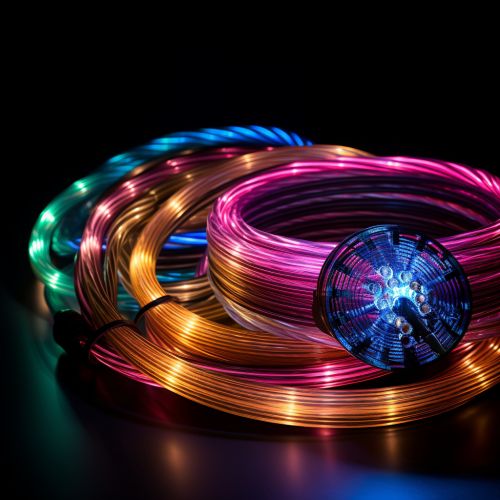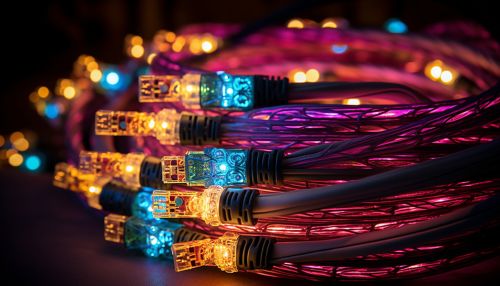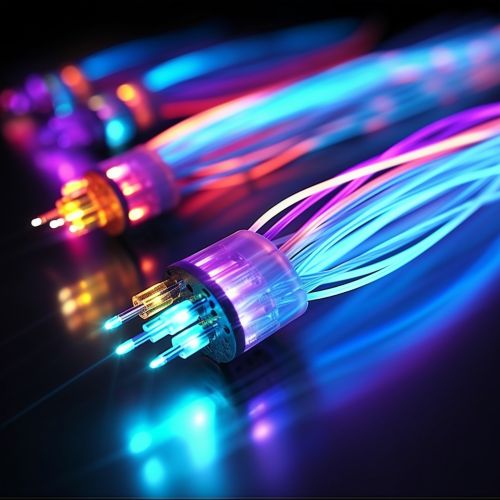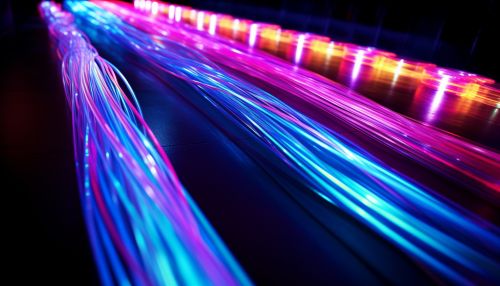Fiber Optic Communication
Introduction
Fiber optic communication is a method of transmitting information from one place to another by sending pulses of light through an optical fiber. The light forms an electromagnetic carrier wave that is modulated to carry information. Fiber is preferred over electrical cabling when high bandwidth, long distance, or immunity to electromagnetic interference are required.
History
The history of fiber optic communication began in the 19th century with the exploration of guiding light by refraction. The principle was first demonstrated by Daniel Colladon and Jacques Babinet in Paris in the early 1840s. The practical application of this technology, however, did not come until the 20th century when advances in materials science made the transmission of light over long distances possible.


Principles of Operation
Fiber optic communication systems consist of three main components: an optical transmitter, which converts an electrical signal into an optical signal; an optical fiber, which carries the light; and an optical receiver, which reproduces the signal as an electrical signal. The information transmitted is typically digital information generated by computers, telephone systems, and cable television companies.
Optical Transmitters
Optical transmitters are the devices that convert an electrical signal into an optical signal. The most commonly used optical transmitters are semiconductor devices such as light-emitting diodes (LEDs) and laser diodes. The difference between LEDs and laser diodes is that LEDs produce incoherent light, while laser diodes produce coherent light.
Optical Fiber
The optical fiber consists of a core and a cladding layer, selected for total internal reflection due to the difference in the refractive index between the two. In practical fibers, the cladding is usually coated with a layer of acrylate polymer or polyimide. This coating protects the fiber from damage but does not contribute to its optical wave guide properties.
Optical Receivers
Optical receivers are the devices that receive the optical signal from the fiber and convert it back into an electrical signal. The most common type of optical receiver is a photodiode, such as a p-i-n photodiode or an avalanche photodiode.
Advantages of Fiber Optic Communication
Fiber optic communication has several advantages over traditional metal communication lines:
- Fiber optic cables have a much greater bandwidth than metal cables. This means that they can carry more data.
- Fiber optic cables are less susceptible to interference than metal cables. They do not suffer from crosstalk, which is when signals from different channels interfere with each other.
- Fiber optic cables are much thinner and lighter than metal wires.
- Data travels with less loss through fiber optic cables.
- Fiber optic cables are immune to electromagnetic interference.
Disadvantages of Fiber Optic Communication
Despite its many advantages, there are also several disadvantages to using fiber optic communication:
- Fiber optic communication systems are expensive, due to the cost of the fibers and other components.
- Fiber optic cables are more fragile than metal wires.
- Fiber optic cables are difficult to splice, and there is loss of the signal at the splices.
- Fiber optic cables are difficult to install and require special training to install them.
Applications
Fiber optic communication is used in a wide range of applications, including:
- Telecommunications: Fiber optic communication is used extensively in the telecommunications industry. It is used for long distance and high demand applications.
- Internet: Fiber optic communication is used to transmit data over the internet. It is used in both backbone networks and for last mile connectivity.
- Military and space: Fiber optic communication is used in the military and in space applications due to its immunity to electromagnetic interference.
- Medical: Fiber optic communication is used in medical applications for imaging and light delivery.


